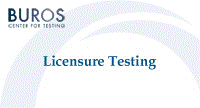Buros-Nebraska Series on Measurement and Testing

Licensure Testing: Purposes, Procedures, and Practices
Date of this Version
7-1995
Document Type
Article
Citation
Licensure Testing: Purposes, Procedures, and Practices, ed. James C. Impara (Lincoln, NE: Buros Institute of Mental Measurements, University of Nebraska-Lincoln, 1995).
Abstract
This book represents a unique effort for the Buros Institute of Mental Measurements and the Buros-Nebraska Series on Measurement and Testing. All of the previous books in this series have been associated with a symposium sponsored by the Buros Institute of Mental Measurements and the University of Nebraska. This book is "free standing" in that it is an independent effort intended to fulfill a perceived need for a book, but without preceding the book with a symposium. There are few books devoted solely to the topic of licensure testing, but each state and the federal government is involved in this form of testing. Licensure testing is far too important to be undertaken casually, because it is big business and it has implications and consequences for thousands of people annually. Every author in this book is involved in some way with licensure testing. Some authors work for professional organizations that are responsible for development of licensure tests. Other authors work for companies that contract with licensure boards to develop licensure tests. The rest serve as consultants to one or more licensure boards to assist in the development and maintenance of licensure testing programs.
The intent of this book is to provide licensure board members with practical information that will help them to understand and carry out their measurement related responsibilities. Many licensure boards employ consultants to assist in developing or selecting measures to use in making the licensure decision. They employ such consultants for a number of reasons (e.g., because they do not have large numbers of employees who are trained in test development, because the occupations they are charged with regulating may have only small numbers of applicants, or because they have little funding and must issue licenses based on results of tests developed by national professional organizations). The reason for employing outside consultants is not really material, the board is the legally responsible agent and the board must make decisions about the test. This book is intended to help board members make such decisions.
This book is also intended to aid measurement consultants by providing them with specific information written in the context of licensure testing. This book provides some technical guidance useful in the development of licensure tests. Most chapters contain some technical content (especially the chapters in Part Two); however, there was an attempt to make most of the content readable by board members while providing measurement consultants with guidelines and references that will assist them in their consulting role.
All the authors in this book tried to walk a fine line between writing for board members and for measurement experts alike. I hope we have achieved that end.
The book is divided into three parts: Part One addresses the purposes for licensure and it includes discussion of legal and policy issues in licensure. The contents of the three chapters in Part One represent essential knowledge for licensure board members. These three chapters constitute the basis for licensure testing and are entirely nontechnical. Part Two provides the details of setting up and operating a licensure testing program. This part represents the bulk of the book and it consists of the rationale for the various steps involved in developing a licensure test and those activities necessary for operating an ongoing licensure testing program. It provides the licensure board member with an understanding of why certain activities must be undertaken (such as a job analysis and conducting an analysis of differential item functioning for different candidate populations) and it contains information helpful in making decisions about such issues as which testing strategies and which methods of setting the cut score are most appropriate under different conditions. The basis for doing many of the technical tasks is also explained in ways a board member can understand. The measurement consultant will also appreciate this part of the book. It provides the details and rationale for undertaking many of the technical steps used in developing and maintaining a licensure testing program. It does not always go into the level of detail necessary for the measurement expert, but when that level of detail is missing the reference list should provide citations to aid the expert. In Part Three some futuristic looks at the practice of licensure testing m·e taken.
Included in
Adult and Continuing Education and Teaching Commons, Educational Assessment, Evaluation, and Research Commons, Other Education Commons


Comments
Copyright © 1995 by Buros Institute of Mental Measurements. Digital Edition copyright © 2012 Buros Center for Testing.